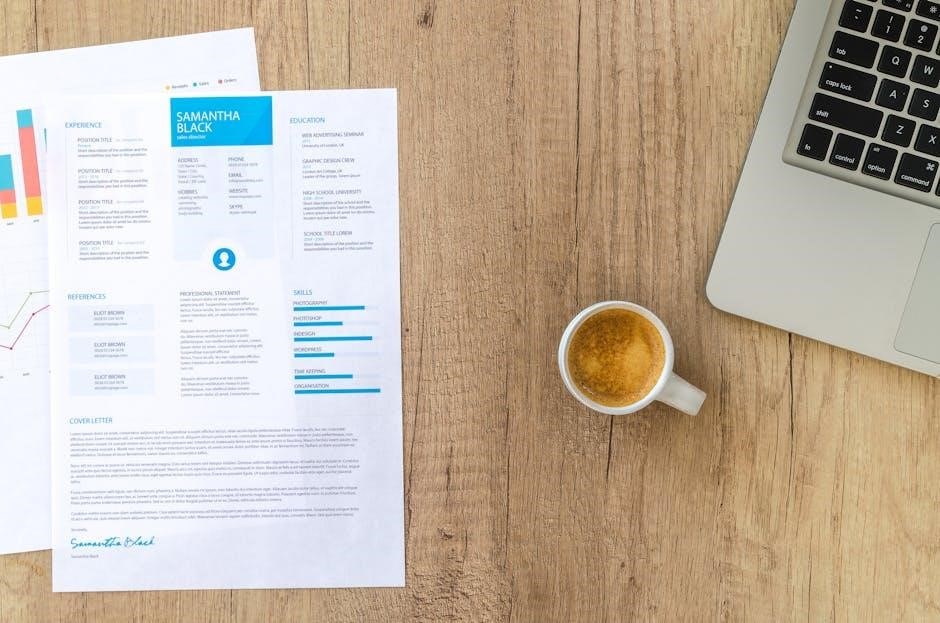Temperature conversion is the process of changing temperature readings from one unit to another, such as Celsius to Fahrenheit. This is essential for various applications, including cooking, scientific research, and engineering, where precise temperature measurements are critical. A Celsius to Fahrenheit chart provides a quick reference guide, ensuring accuracy and efficiency in conversions.
1.1 Importance of Understanding Temperature Scales
Understanding temperature scales is crucial for accurate conversions between Celsius and Fahrenheit. Many everyday activities, such as cooking and scientific experiments, rely on precise temperature measurements. Misunderstanding these scales can lead to errors in recipes, experiments, or engineering calculations. A Celsius to Fahrenheit chart serves as a reliable tool to avoid mistakes, ensuring consistency across applications. Whether for baking, laboratory work, or weather forecasting, knowing how to interpret and convert temperatures accurately is essential for achieving desired outcomes. This knowledge fosters efficiency and precision in both professional and personal tasks, making it a fundamental skill in various fields.
1.2 Brief Overview of Celsius and Fahrenheit Scales
The Celsius and Fahrenheit scales are two widely used temperature measurement systems. The Celsius scale, developed by Anders Celsius, sets the freezing point of water at 0°C and boiling point at 100°C. The Fahrenheit scale, created by Gabriel Fahrenheit, assigns these points as 32°F and 212°F, respectively. Both scales are linear but differ in their degree intervals and reference points. Understanding these basics is vital for accurate conversions, especially when using a Celsius to Fahrenheit chart. This chart provides a visual guide to quickly convert temperatures, ensuring precision in cooking, science, and engineering applications where temperature accuracy is critical.

The Basics of the Celsius and Fahrenheit Scales
The Celsius and Fahrenheit scales are fundamental temperature measurement systems. Anders Celsius developed the Celsius scale, while Gabriel Fahrenheit created the Fahrenheit scale. Both are widely used globally.
2.1 History and Development of the Celsius Scale
The Celsius scale was created by Swedish astronomer Anders Celsius in 1742. Initially, he proposed an inverted scale where 100°C was the freezing point of water and 0°C the boiling point. After his death, Carl Linnaeus reversed the scale in 1745, establishing the modern system where water freezes at 0°C and boils at 100°C. This change made the scale more practical for scientific use. The Celsius scale gained international acceptance and is now the standard for most countries and scientific applications, with its simplicity and logical structure making it a cornerstone in global temperature measurement.
2.2 History and Development of the Fahrenheit Scale
The Fahrenheit scale was developed by German physicist Gabriel Fahrenheit in 1724. He established the scale using three fixed reference points: the freezing point of a saltwater mixture at 0°F, average human body temperature at 96°F, and water’s boiling point at 212°F. Later, the scale was slightly adjusted so that water freezes at 32°F and boils at 212°F. Fahrenheit’s scale was widely used in English-speaking countries, particularly in the United States, for everyday applications like weather forecasting and cooking. Despite its historical significance, the Celsius scale has largely replaced Fahrenheit in most scientific and international contexts.
2.3 Key Differences Between Celsius and Fahrenheit
The Celsius and Fahrenheit scales differ in their reference points and degree intervals. Celsius is based on the freezing and boiling points of water at 0°C and 100°C, respectively, while Fahrenheit sets these points at 32°F and 212°F. Each degree in Celsius is equivalent to 1.8 degrees in Fahrenheit, making Celsius intervals larger. The formulas for conversion also highlight their differences: ( F = rac{9}{5}C + 32 ) and ( C = rac{5}{9}(F ⎼ 32) ). Celsius is used in most scientific and international contexts, while Fahrenheit remains common in the U.S. for everyday applications like weather and cooking.

The Conversion Formula
The formula to convert Celsius to Fahrenheit is F = (9/5)C + 32, enabling accurate temperature conversions. This formula is essential for creating precise conversion charts.
3.1 Mathematical Formula for Celsius to Fahrenheit Conversion
The mathematical formula to convert temperatures from Celsius to Fahrenheit is F = (9/5)C + 32. This equation allows precise conversion by multiplying the Celsius temperature by 9/5 and then adding 32. It is universally applied to ensure accuracy in various fields, including cooking, engineering, and meteorology. Understanding this formula is essential for creating reliable conversion charts, as it forms the basis for all calculations. By applying this formula consistently, users can trust the accuracy of their temperature conversions, making it a fundamental tool for anyone working with Celsius and Fahrenheit scales.
3.2 Step-by-Step Guide to Using the Formula
Converting Celsius to Fahrenheit is straightforward using the formula F = (9/5)C + 32. First, identify the temperature in Celsius. Next, multiply this value by 9/5. Then, add 32 to the result. For example, to convert 30°C, calculate (9/5)*30 = 54, then add 32 to get 86°F. Ensure accuracy by rounding to the nearest whole number if necessary. This method guarantees precise conversions, making it ideal for creating reliable charts. By following these steps, users can easily switch between Celsius and Fahrenheit, ensuring consistency and accuracy in their temperature measurements and applications.

Creating a Celsius to Fahrenheit Chart
Creating a Celsius to Fahrenheit chart involves listing temperatures in both scales, ensuring accuracy and readability. Use consistent intervals and clear formatting for easy reference.
4.1 Benefits of Using a Conversion Chart
A Celsius to Fahrenheit conversion chart offers numerous benefits, particularly for quick and accurate temperature conversions. It provides a visual reference, making it easier to compare temperatures at a glance. This tool is especially useful for individuals who frequently work with both scales, such as chefs, scientists, and engineers. By listing corresponding temperatures in a structured format, the chart eliminates the need for complex calculations, saving time and reducing errors. Additionally, it enhances readability and consistency, ensuring that everyone using the chart references the same conversions; This makes it an indispensable resource for both professional and everyday applications.
4.2 How to Design a PDF Chart for Easy Reference
Designing a Celsius to Fahrenheit chart in PDF format requires careful planning to ensure ease of use. Start with a clean layout, using a clear title and headings. Organize the chart in a grid format, listing Celsius temperatures alongside their Fahrenheit equivalents. Choose a readable font and use contrasting colors for clarity. Include a formula at the top for quick conversions. Add a key or legend if necessary. Ensure the chart is sorted in ascending order for easy navigation. Avoid clutter by keeping margins ample and spacing consistent. Finally, save it as a PDF/A to ensure compatibility across devices.

Practical Applications of the Chart
A Celsius to Fahrenheit chart is essential for everyday tasks like cooking, baking, and weather monitoring. It aids professionals in engineering, science, and healthcare, ensuring accurate conversions.
5.1 Using the Chart in Cooking and Baking
A Celsius to Fahrenheit chart is invaluable in cooking and baking, where precise temperature control is critical. Recipes often require conversions, such as adjusting oven temperatures for international recipes or ensuring proper dough proofing. For instance, converting 180°C to 350°F ensures cookies bake correctly. The chart simplifies these tasks, preventing errors that could ruin dishes. It’s especially useful for delicate processes like candy making or bread baking, where temperature accuracy is key. By referencing the chart, home cooks and professional chefs can achieve consistent results, ensuring dishes turn out as intended every time.
5.2 Using the Chart in Scientific and Engineering Applications
In scientific and engineering fields, precise temperature measurements are essential, making a Celsius to Fahrenheit chart a valuable tool. Researchers and engineers often work with data that requires conversions, such as materials testing, climate modeling, or industrial manufacturing. For example, understanding the freezing point of water (0°C = 32°F) or the boiling point (100°C = 212°F) is crucial for experiments. The chart ensures accuracy in calculations, preventing errors that could lead to safety risks or equipment failure. It’s particularly useful in cross-border collaborations, where standards may differ, and consistent data interpretation is vital for reliable outcomes and innovation.

Downloading and Printing the Chart

Download reliable Celsius to Fahrenheit charts from reputable sources like scientific websites or conversion tools. Ensure the PDF is high-resolution for clarity when printing.
6.1 Where to Find Reliable PDF Charts Online
Reliable Celsius to Fahrenheit charts can be found on reputable educational, scientific, or governmental websites. Websites like NASA, NOAA, or trusted conversion tool platforms often provide accurate and downloadable PDF charts. Additionally, many online repositories and forums dedicated to temperature conversion offer free, high-quality charts. When searching, use specific keywords like “centigrade to Fahrenheit chart PDF” or “temperature conversion table PDF” to find the most relevant results. Ensure the source is credible to avoid errors in the chart. Always verify the chart’s accuracy before downloading to ensure it meets your needs for precise temperature conversions.
6.2 Tips for Printing the Chart for Optimal Clarity
For optimal clarity when printing a Celsius to Fahrenheit chart, ensure your printer is set to high-resolution settings (300 DPI or higher). Choose a standard paper size like A4 or Letter to maintain readability. Use thick, high-quality paper to prevent ink bleed and ensure vibrant colors. If the chart includes fine details, avoid scaling it down. Print in landscape orientation for better visibility of temperature ranges. For durability, consider laminating the chart after printing. Finally, preview the PDF before printing to ensure proper alignment and margins. These steps will ensure your chart is clear, professional, and easy to read.

Common Mistakes in Temperature Conversion

Common mistakes involve reversing the conversion formula, misapplying the offset, and rounding inaccuracies. Always verify each step and use reliable tools for accuracy.
7.1 Avoiding Errors When Using the Chart
When using a Celsius to Fahrenheit chart, errors can occur due to misreading values or relying solely on visual approximations. To avoid mistakes, cross-verify with the mathematical formula: F = (C × 9/5) + 32. Ensure the chart is printed clearly, with visible grid lines and legible numbers. Double-check the scale alignment, as small misalignments can lead to significant errors. For precise conversions, use digital tools or calculators alongside the chart. Always verify critical conversions, especially in scientific or cooking applications, where accuracy is crucial. Understanding the conversion process, rather than relying solely on the chart, helps in catching potential errors early.
7.2 Troubleshooting Conversion Discrepancies
Discrepancies in temperature conversion can arise from rounding differences or misalignment with the chart. To troubleshoot, identify the source of the mismatch by cross-referencing with the formula: F = (C × 9/5) + 32. Check if the chart is outdated or if values were misread. Ensure the chart’s scale is accurately calibrated and that measurements align properly. For critical applications, verify conversions using digital tools or calculators. If discrepancies persist, consult multiple reliable sources or re-download the chart to ensure accuracy. Regularly updating and recalibrating your conversion tools can minimize errors and ensure consistent results.

The Importance of Accuracy in Conversion
Accuracy in temperature conversion is crucial for reliable results, especially in cooking, science, and engineering. Small errors can lead to significant discrepancies, affecting outcomes and safety.
8.1 Why Precision Matters in Temperature Conversion
Precision in temperature conversion is critical to ensure accuracy in various applications. Even small discrepancies can lead to significant errors, especially in cooking, engineering, and scientific research. For instance, in baking, a slight miscalculation can alter the texture and consistency of baked goods. Similarly, in engineering, precise temperature control is essential for material properties and safety standards. Using a reliable centigrade to Fahrenheit chart PDF helps maintain consistency and avoids errors. In scientific experiments, accurate conversions are vital for reproducibility and valid results. Thus, precision ensures reliability and prevents potential failures or safety risks in temperature-dependent tasks.
8;2 Real-World Consequences of Inaccurate Conversions
Inaccurate temperature conversions can have serious real-world consequences. For example, in industrial manufacturing, incorrect readings can damage equipment or lead to product defects. In cooking, improper conversions may result in undercooked or overcooked dishes, posing food safety risks. In scientific research, errors can invalidate experimental results, wasting time and resources. Even in weather forecasting, misinterpretations can lead to incorrect predictions, affecting public safety. Using a reliable centigrade to Fahrenheit chart PDF minimizes these risks by providing accurate reference points. The stakes are high, making precision essential in all temperature-dependent applications.
A reliable centigrade to Fahrenheit chart PDF is indispensable for accurate temperature conversions. It ensures precision in cooking, scientific research, and industrial applications, saving time and resources while maintaining safety and quality in various fields.
9.1 Summary of Key Points
A Celsius to Fahrenheit chart PDF is an essential tool for anyone needing to convert temperatures between the two scales. It provides a quick and accurate reference, saving time and reducing errors. The chart is particularly useful for cooking, baking, and scientific applications, where precise temperature control is crucial. By including common temperature ranges and conversions, it serves as a handy guide for both everyday use and professional settings. Its availability in a PDF format ensures easy access and printing, making it a valuable resource for anyone requiring frequent temperature conversions. This chart simplifies the process, ensuring accuracy and efficiency.
9.2 Final Thoughts on the Value of a Celsius to Fahrenheit Chart
A Celsius to Fahrenheit chart PDF is an indispensable resource for seamless temperature conversions, offering convenience and reliability. Its clear, organized format makes it easy to use, whether for everyday tasks or professional applications. By eliminating the need for complex calculations, it saves time and minimizes errors. The portability of the PDF format ensures accessibility across devices, making it a versatile tool for diverse needs. For anyone working with temperature measurements, this chart is not just helpful—it’s essential. Its practicality and efficiency make it a must-have resource for ensuring accuracy and streamlining tasks that require temperature conversions.

Be First to Comment